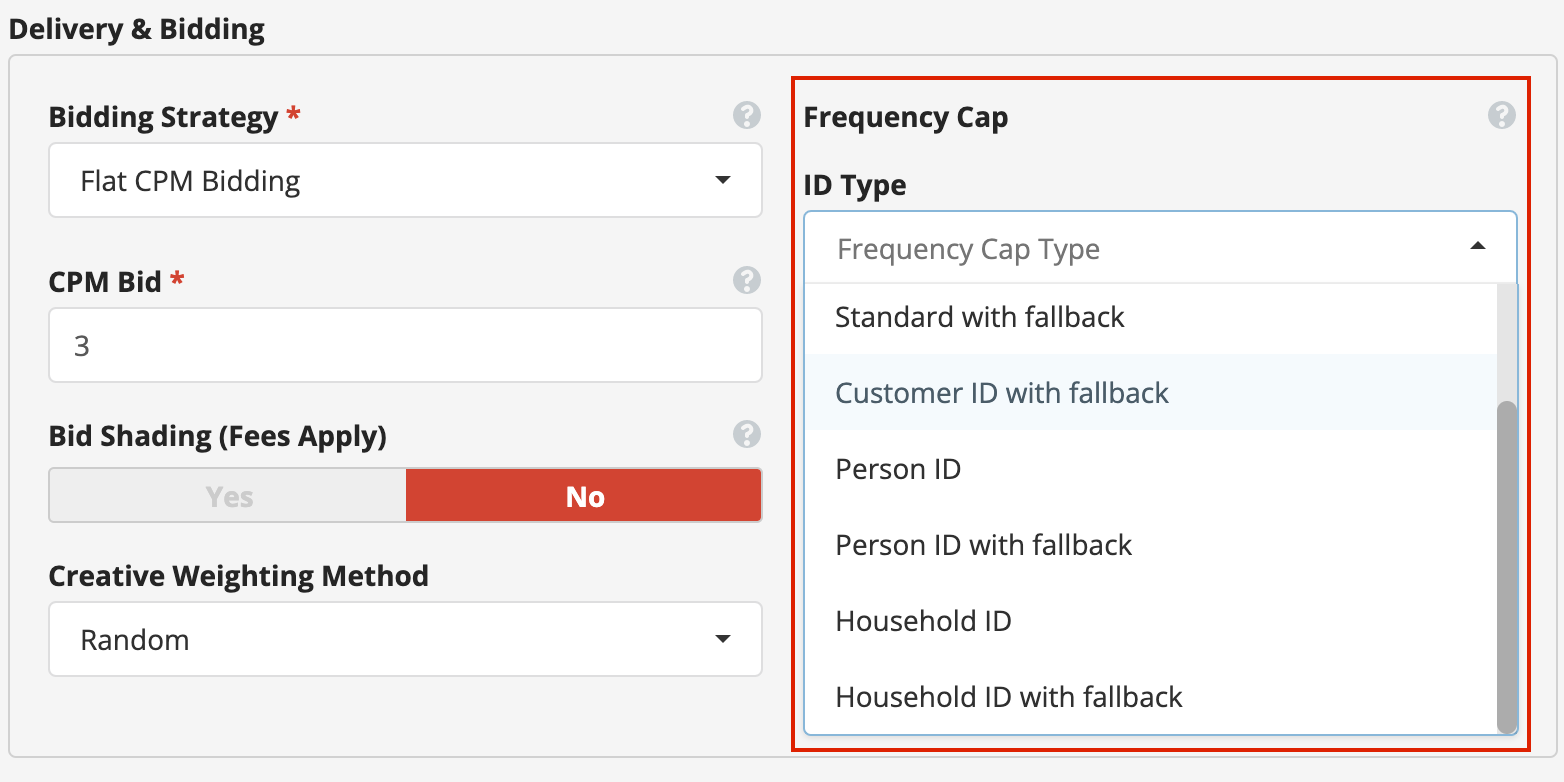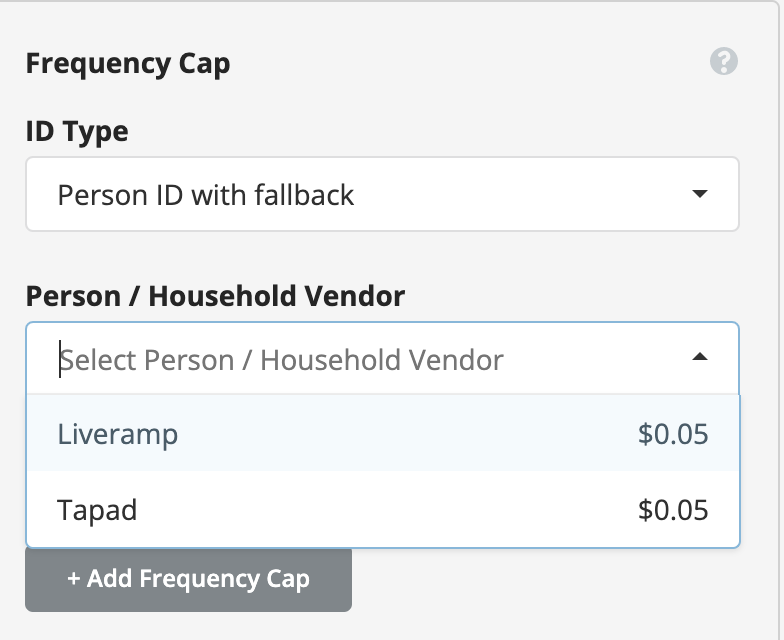Frequency Caps
When trafficking a Campaign and/or Line Item, you have the option of setting a Frequency Cap to restrict the number of times a particular ad will be shown to a particular user. Frequency is typically determined by the ID found in the bidRequest.user.buyeruserID or device.ifa openRTB fields, which correspond to the AIDEM cookie ID on web traffic, and the mobile device ID on in-app traffic. Additionally, AIDEM has optional support for enhanced frequency capping on IP Address, IDFV, proprietary customer IDs, and cross device IDs.
Note: Frequency Caps are enabled on impression (not on the bid) and are calculated per Data Center for Serving purposes.
To find this feature, when logged into the AIDEM UI click Create > Campaign or Line Item. Frequency Cap settings can be found in either the Edit Line Item (or Edit Campaign) screen under the Delivery & Bidding section.

Frequency Caps can be set at either or both levels, within AIDEM. Frequency Cap functionality remains the same at either level, although its effect upon delivery can vary depending on implementation. When using Enhanced Frequency Capping, you will need to ensure that the type of ID is uniform on both the Campaign and Line Item, if a cap is set on both levels.
A frequency cap is expressed in terms of a count (N) and a duration (M): "Show line item X to each user no more than N times every M hours/days/weeks." Durations of hours, days, and weeks represent rolling windows of time. For example: a cap of "1 impressions per hour" means that a user who sees an impression at 8:59am will not be eligible to see that line item again until 9:59am. Please note that the maximum duration of any discrete frequency cap is 30 days (or 2,592,000 seconds).
It is recommended to implement Frequency Caps at the most granular level (e.g. Line Item level), although additional use cases are supported. Implementing Caps at the Campaign level can exhibit different behavior than if implemented at the Line Item level (and different still if implemented across both, depending on Campaign and Line Item setup). For example: you may wish to cap ads at 2 times per day. Consider that you have a single Campaign (A) with three associated Line Items (1), (2) and (3), each with their own respective targeting criteria.
Campaign Level Implementation
A user requests an ad 6 times in a given day and matches the targeting of all Lines Items. They could be shown any combination of Lines (1), (2) OR (3) for at most of TWO total ads.
Line Item Level Implementation
A user requests an ad 6 times in a given day and matches the targeting of all Lines Items. They could be shown Lines (1), (2) AND (3) at most of two times EACH (or SIX total ads).
Campaign AND Line Item Level Implementation
A user requests an ad 6 times in a given day and matches the targeting of all Lines Items. They could be shown any combination of Lines (1), (2) OR (3) for at most of TWO total ads. In other words, the Line Item Cap would be superseded by the Campaign Cap.
Enhanced Frequency Capping
AIDEM allows our customers to frequency cap on identifiers besides a AIDEM cookie ID (in Web environments) or a Device ID (in mobile app and/or Connected TV environments). This can include a full (non-truncated) IP Address, a Customer ID, or a Cross Device identifier, each of which will be read or mapped from the bid request. AIDEM also supports using multiple IDs as a ‘fallback’ mechanism.
IP Address Frequency Capping
In order to start frequency capping using IP Address, please ask your Customer Success Manager to turn this functionality on for your Buzz Key.
Once enabled a new option will be viewable at both the Line Item and Campaign levels called Frequency Cap ID Type.The Frequency Cap ID Type dropdown contains the following options:
- Standard
- IP Address
- Standard with fallback
- Customer ID with fallback
- Person ID
- Person ID with fallback
- Household ID
- Household ID with fallback
Customer ID Frequency Capping
For customers that have their own ID space that is passed within the bid request, AIDEM has the ability to frequency cap on these inbound user IDs. This use case is generally only available to exchanges or other media companies that can control the RTB input into AIDEM. In order to start frequency capping using a Customer ID, please ask your Customer Success Manager to turn this functionality on for your Buzz Key.
Once enabled, two new options for Frequency Cap ID Types will be available: Customer IDs and Customer IDs with Fallback.
Cross Device Frequency Capping
In order to enable frequency capping on Cross Device IDs, please reach out to your Customer Success Manager.
Once enabled, four new options for Frequency Cap ID Types will be available: Person ID, Person ID with Fallback, Household ID, and Household ID with Fallback.

This feature is currently supported by LiveRamp and Tapad. If both Cross Device vendors are enabled for your Buzz Key, a dropdown menu will appear with the option to select a “Person / Household Vendor”. If only one Cross Device vendor is enabled for your Buzz Key, the frequency cap selection will automatically default to that vendor.
A fee of $0.05 CPM is charged to the customer whenever a Cross Device ID (LiveRamp or Tapad) is used for frequency capping. For the options which use a Cross Device ID as the primary ID to frequency cap on but fall back to other IDs, the fee will ONLY be charged if the Cross Device ID is actually used for frequency capping

Campaign and Line Item Caps
If setting a frequency cap at both Campaign and Line Item levels, the Frequency Cap ID Type will need to match on both objects. However, you are able to set different ID Types on different Line Items within a Campaign if a cap is not set at the campaign level.
Summary of Frequency Cap Options
| FCap User ID Type | How it Works | Use Cases |
|---|---|---|
| Standard | This is the default option and uses the AIDEM web cookie OR the in-app device ID OR the Connected TV ID. | Generally covers most use cases. |
| IP Address | This frequency caps on the IP address included in the bid request. AIDEM only frequency caps on full IP addresses. If an IP address in a bid request is truncated for any reason (e.g. specific exchanges, no GDPR consent) then it will lack the precision required, and that impression will not be bid on for line items/campaigns with this type of frequency cap applied. | - Customers who use IP address based segment targeting. - Connected TV buyers may find IP addresses to be more stable user ID than CTV IDs. |
| Standard with Fallback | This frequency caps on AIDEM cookie ID/device ID when present and falls back to IP address when the ID is not present. In mobile app, if device ID and IP address are not present, it falls back to using IDFV. | - For campaigns that do not have segment targeting, this option will provide more scale since some auctions do not have a cookie/device ID.If a Line Item is targeted to a Deal ID where the supply is premium and you wish to bid on supply with or without user ID. - As third-party cookies become less common, this may also be preferred by customers who want to ensure maximum scale. |
| Customer ID or Customer ID with Fallback | This uses the auction-provided customer ID when present and on a bid request, and falls back to the Standard option when customer ID is not present. In mobile app, if device ID and IP address are not present, it falls back to using IDFV. | Customers who are buying-their-own-supply and have their own proprietary user ID. Publisher Networks or alliances who have a unified ID across their network and can request their partner SSPs to send through their User ID in the bid request. |
| Person ID or Person ID with Fallback | This uses the person ID mapped through the chosen cross device vendor. If using the fallback option, the frequency cap reverts to identifiers in the following order: Bito or MAID → IP address → IDFV in cases where the LiveRamp or Tapad person ID is not present. | For customers that want to frequency cap across a user’s various devices. |
| Household ID or Household ID with Fallback | This uses the household ID mapped through the chosen cross device vendor. If using the fallback option, the frequency cap reverts to identifiers in the following order: Bito or MAID → IP address → IDFV in cases where the LiveRamp or Tapad household ID is not present. | For customers that want to frequency cap across devices in a household. |
FAQs
Q: Is there a fee associated with using frequency capping on other IDs?
A: Only for the use of Cross Device ID for frequency capping.
Q: For frequency capping, can I set a different Frequency Cap User ID type at the Campaign and Line Item level?
A: No, the Buzz UI and API validate against this. However, you could specify different Frequency Cap User ID types on different Line Items within a Campaign.
Q: Aren't IP Addresses considered PII? How is AIDEM able to use them?
A: Under GDPR, IP Addresses are considered "Personal Data" on the same level of control as cookies or MAIDs. Our system's handling of requirements for GDPR and CCPA treats IP Addresses in a very comparable manner to cookies and will not utilize them when consent is not present (or an opt-out is received).
Q: For frequency capping on IP addresses, does AIDEM handle IP addresses of type ipv6?
A: Yes.
Q: Let’s say I have a frequency of 1 imp / day, I’m using the ‘standard with fallback’ method, and I serve one impression to cookie ID A who has IP address 1.1.1.1. Then, later on, I get a bid request with no cookie ID, and IP address 1.1.1.1. Does the system bid?
A: Yes, in that case, you would bid - we only count frequency on one ID at a time. In other words, the first impression was counted against the cookie ID without consideration for the IP, as the fallback is only used when the primary ID type is missing.
Q: Can Cross Device Frequency Capping be used globally?
A: Use of this feature is currently limited to NAM.
Q: If I use Cross Device for both audience extension and frequency capping, will I be charged for both associated fees?
A: Yes. The features work independently of one another, so the customer is responsible for the separate fees. If Cross Device is used for both audience extension and frequency capping, the customer will be charged a total of $0.55CPM ($0.50 CPM for audience extension and $0.05 CPM for frequency capping).
Q: Can I use different Cross Device vendors for audience extension and frequency capping?
A: Yes.
Q: Is Cross Device ID for frequency cap enabled by default?
A: No, please reach out to your Customer Success Manager to have this enabled.
Q: Will frequency cap ID type show up in logs? How can I verify which frequency cap ID type was used on an auction?
A: You must be subscribed to win logs, where the “freq_cap_type” column will contain values to indicate the Cross Device vendor and ID type used. The values will be either “TAPAD_PERSON”, “TAPAD_HOUSEHOLD”,”LIVERAMP_PERSON” or “LIVERAMP_HOUSEHOLD”.
Q: How do Cross Device frequency cap fees show up in reporting?
A: The fees will be listed in the Vendor Report with a Vendor Name value of either “LIVERAMP” or “TAPAD”, and a Vendor Fee Name of “Cross Device Fcap Fee”.